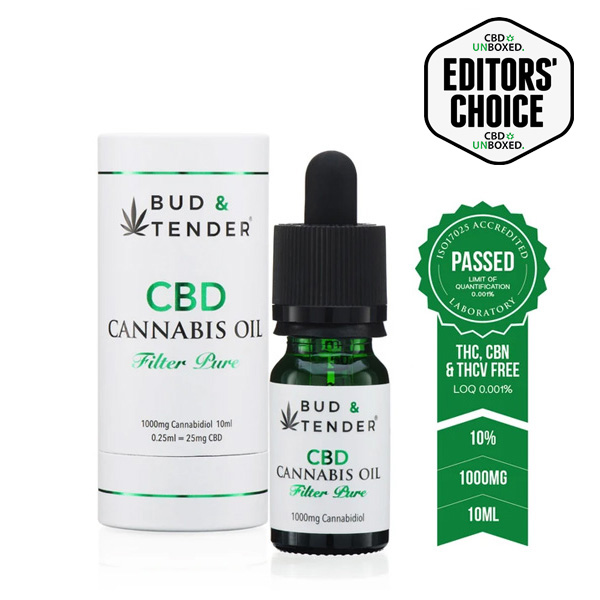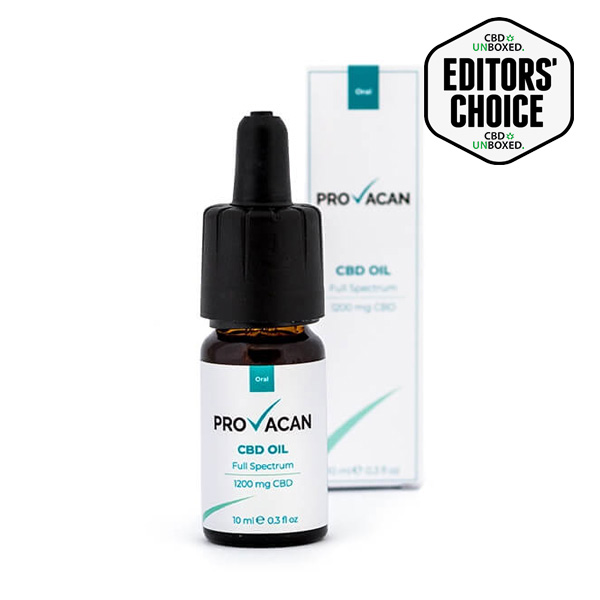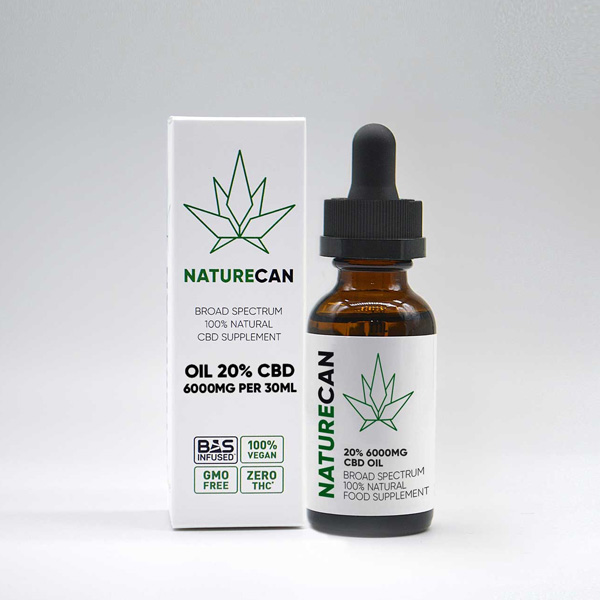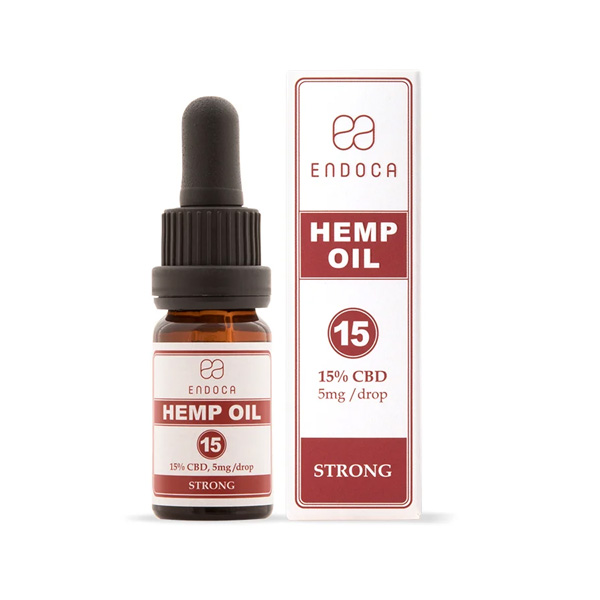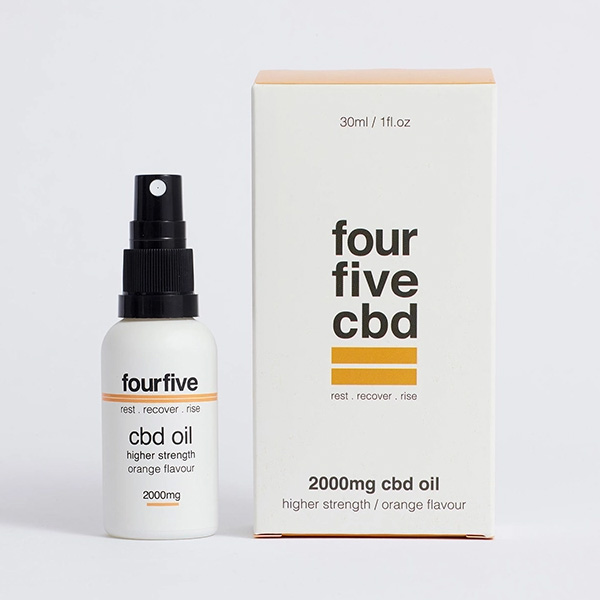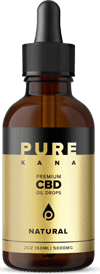New to CBD and suffering from headaches? This guide to CBD will help you understand how CBD can reduce the frequency and severity of your headaches. We also list the Best CBD Oils for Headache Sufferers at the end of this article.
CBD for Headaches – The Ultimate Guide
According to the World Health Organization, it has been estimated that prevalence among adults of current headache disorder (once within the last year) is about 50%. Half to three quarters of adults aged 18–65 years in the world have had headache in the last year and, among those individuals, 30% or more have reported migraine.
Headache on 15 or more days every month affects 2–4% of the world’s adult population. Despite regional variations, headache disorders are a worldwide problem, affecting people of all ages, races, income levels and geographical areas.
Whether your experience headaches on a regular basis or once a year, it can not only be quite painful but also incredibly debilitating.
Choosing CBD, a popular product made from hemp extract (cannabis plant), is a natural way to manage the frequency and intensity of your headaches, without any of the major side effects of traditional headache and pain medication.
In this article we discuss the benefits of CBD oil for headache sufferers based on research papers and peer-reviewed studies. We explain how CBD oil can help with headache disorders and provide links to purchase high quality CBD oils we’ve tried and tested.
Take our CBD Quiz
If after reading this guide you are still unsure about what products to choose to help with your headaches, simply take our CBD Quiz which has been designed specifically to identify the product and strength that is best suited to your personal needs.
CBD has been proven to reduce the frequency of headaches as well as reduce stress and improve sleep, two major triggers of headaches. But CBD also has strong analgesic (pain relief) and antiemetic (prevent vomiting) properties which can help people with headache disorders during an attack.
What is CBD?

Cannabis (or Marijuana) and hemp are the same plant and come from the Cannabaceae family. Both plants are filled with organic compounds known as “cannabinoids”. Hemp has over 112 different cannabinoids, all of which have their own health benefits.
The main two cannabinoids or compounds of the hemp plant are THC (also known as “Tetrahydrocannabinol”) and CBD (also known as “Cannabidiol”).
THC is the compound known to give cannabis smokers this feeling of “high” and is currently illegal in the UK.
CBD on the other hand, contains none of the psychoactive properties associated with THC (meaning it won’t get you “high”) and is completely legal in the UK. It is also non-addictive and has been suggested to have several medical benefits. Some of these benefits include reducing anxiety and depression, improving sleep and insomnia, reducing pain and inflammation, as well as helping with stress or neurological disorders.
These benefits are possible because CBD interacts with your “Endocannabinoid System” (ECS), which essentially monitors and regulate key functions of your body such as your heat level, your food intake, your hormone levels and so on. When your ECS detects that something is operating outside of what it considers to be its “normal range”, it activates to bring things back to its baseline. If you are exercising and become too hot, your ECS activates and makes you sweat to bring your temperature down. If you need more calories for your body to keep performing (for example running) but you aren’t feeding it, your ECS may start redirecting the energy available towards vital organs such as the heart and brain, leading to a drop in physical performance.
The term Endocannabinoid can be broken down into two parts:
- Cannabinoid: which comes from Cannabis
- Endo: which is short for “Endogenous” and means that it is naturally produced by your body.
So endocannabinoid simply means that your body naturally produces cannabinoids, and does so thanks to cannabinoid receptors present in the body, which fall under two categories:
CB1 Receptors

CB1 receptors, which are located in various regions of the body, with a large concentration in the brain and the nerves of the spinal cord, co-ordinate mood, emotion, appetite, and other functions.
CB2 Receptors

CB2 receptors are more commonly found in the immune system and are responsible for controlling inflammation and pain. CBD stimulates these receptors and induces the body to release serotonin.
Serotonin, or 5-HT, is a neurotransmitter that carries signals from one neuron to the other. CBD increases the level of serotonin, which, in return, helps reduce pain, reduce inflammation in the body and possibly reduces the cramping experienced during period pain.
Whilst there are very few differences between “Marijuana” and “Hemp”, the main difference is simply legal and linked to the level of THC that is present in the plant. So different parts of the cannabis plant are either defined as hemp or as cannabis / marijuana.
- Hemp: hemp is the stalks, stems and sterilized seeds of cannabis sativa (“Cannabis Sativa” is the scientific Latin term that defines hemp, cannabis or marijuana plant species)
- Cannabis and Marijuana: the leaves, flowers and viable seeds of cannabis sativa
The varieties of cannabis that are regulated, legal and available in the UK are those that produce less than 0.2 percent THC. And given the fact that most THC is in the flowers, CBD products are primarily made from hemp (stalks, stems and sterilized seeds of cannabis sativa) which contain very little THC and are safe to consume.
There has been a lot of interest in CBD from both the research and medical community over the last few years, due to its range of health applications – including but not limited to pain relief, fighting the side effects of cancer medications, alleviating insomnia, lowering stress levels, improving acne outbreaks, counteracting heat disease, or reducing seizures in patients with epilepsy
For all these reasons, CBD products are legal in the UK if they contain less than 0.2% THC and as long as they are advertised as a health supplement and not a medication.
Products containing CBD come in many different forms, with the most common including CBD oils, CBD gummies, CBD capsules, CBD vapes and CBD edibles. Some forms are more fast-acting than others, some have different flavours, some contain differing proportions of CBD extract, and so on, so the type you choose depends entirely upon your personal preferences and the condition you wish to treat.
Here’s what you need to know about using CBD for headaches.
Headaches: What You Need to Know

The term ‘headache disorder’ is characterized by recurrent headaches which are unpleasant for the patient and can, in the most severe cases be quite debilitating.
The pain – which can be defined as an uncomfortable sensation that usually signals an injury or illness – is usually the body’s way of telling you that something is not right and that you should do something about it so the feeling of pain can go away.
When your body experiences a pain stimulus, such as a cut, a burn, a headache or a migraine, the nerves in your body register the stimulus and the nerve fibres in your body send pain signals to your nervous system which carries this signal to your brain.
When you experience pain and pressure in your head, it can be quite difficult to dissociate a headache from a migraine, which is a chronic condition. However, it is crucial to do so quickly, in order to identify the treatment that will bring you the fastest possible relief.
According to the World Health Organization (WHO), headache disorders are among the most common disorders of the nervous system and affect almost half of the adult population worldwide.
- 50% to 75% of adults aged 18–65 years in the world have had headache in the last year
- 30% of those individuals have reported migraine
- Between 2% and 4% of the world’s population suffers from headaches lasting 15 or more days every month.
So, what is a headache and what are the different types of headaches?
Primary vs Secondary Headaches
A headache is usually qualified as ‘unpleasant pain’, a feeling of ‘pressure’ or ‘aching’, which is usually experienced on both sides of your head (temples), although they can also occur in various places including your forehead and the back of your neck. The severity of the pain can range from mild to extremely severe and last from a few minutes to a few days.
Experts have classified headaches into two main groups — primary and secondary headaches.
Primary Headaches
Primary headaches refer to independent conditions that cause pain in the head, face, or neck. Examples of primary headaches include migraines and tension headaches.
Tension Headaches – these types of headaches affect over 42% of adults worldwide and is the most common form of headache pain. The pain tends to be experienced across the temples, but often starts at the back of the neck and creeps forward as the headaches progresses and intensifies. Tension in the scalp can be experienced as a result of tension headaches and scalp massages can sometimes offer temporary relief. offer The main factors causing this type of headache are eye strain, clenching of the jaw, lack of sleep, stress, depression, anxiety, hunger, poor posture leading to increase pressure on the spine and neck. Tension headaches are usually acute but can in some cases be chronic (frequent and long term).
Sinus Headaches – As the name indicates, sinus headaches are caused by the swelling and inflammation of the sinus passages, resulting in pain being experienced behind the eyes, the nose and sometimes the cheeks. Sinus headaches often happen as a result of a cold and congestion of the nasal passages with other symptoms including fever, stuffy nose and a cough. The pain experienced during sinus headaches is often worse when bending forward (for example to tie your shoelaces) as the pressure in the sinuses increases or first thing in the morning when your nose is more congested due to the sleeping position at night. If not treated, sinus headaches can lead to ‘sinusitis’, an infection of the nasal passages.
Cluster Headaches – Unlike tension headaches which tend to strike both sides of the head, cluster headaches usually occur on one side of the head and are severely painful. They are called cluster headaches as they tend to happen in clusters, meaning they happen daily and can sometimes happen multiple times a day. This type of headache tends to be as a result of dilation in the blood vessels of the brain due to a release of serotonin and histamines. According to the National Institutes of Health (NIH), cluster headaches usually last 6 to 12 weeks and will generally affect males more often than females. The main symptoms of cluster headaches include:
- Severe pain on one side of the head
- Pain behind the eye
- Red eyes
- Watery or crying eyes
- Increased heart rate or sweating
- Nasal congestion
Hemicrania Headaches – Similar to cluster headaches, hemicrania headaches is a severe, episodic headache which tends to be unilateral and affect the periorbital and retroorbital regions (around the eyes). In contrast to cluster headaches, which tend to affect men more than women, hemicrania headaches occur more prevalently in women. The duration of pain associated with chronic paroxysmal hemicrania is shorter than that of cluster headache, lasting 5 to 45 minutes. Other symptoms of hemicrania headaches are similar to cluster headaches and include:
- Nausea and vomiting
- Sensitivity to light
- Severe pain on one side of the head
- Pain behind the eye
- Red eyes
- Watery or crying eyes
- Swollen eyelids and nasal congestion
Secondary Headaches
Secondary headaches occur as the result of another medical condition, such as an infection, stress, or medication overuse which tends to affect the nervous system and cause headaches. The causes of secondary headaches are incredibly varied and include:
Physical Deformations – A Chiari headache is caused by a birth defect (Chiari malformation), which causes the skull to push against parts of the brain, often causing pain in the back of the head.
Sleep disorder – Hypnic headache is a rare, primary headache disorder characterized by frequently occurring headaches that happen only during sleep. Sometimes known as “alarm clock” headaches because they occur at night and awaken the person from a sound sleep, these headaches can last between 15 minutes and 4 hours.
Brain Tumours – Although rare as they affect approximately 12,000 people in the UK each year, brain tumors will often start causing headaches in patients when they have become large enough to put pressure on the brain or nerves in the brain.
Stroke – A stroke can often manifest as a sudden and severe headache. However, unlike headaches and migraines, patients suffering from a stroke will often experience other common symptoms including numbness or weakness usually on one side of the body, trouble speaking or understanding others. As time is of the essence, a useful way to quickly identify if someone may be suffering from a stroke is to apply the BE FAST technique which consists of:
- Balance: Do they suddenly suffer from dizziness, a loss of balance or coordination? Ask them to stand on one foot or to touch their nose with their index finger multiple times.
- Eyes: Do they suddenly have trouble seeing out of one or both eyes?
- Face: Are they experiencing facial weakness with one side of the face drooping? Ask them to smile to see if one side of their face does not rise properly.
- Arms: Are they experiencing arm weakness? Ask them to raise both arms above their head or to touch their nose with their index fingers multiple times.
- Speech: Are they struggling to speak. Ask them to repeat simple sentences to check for impaired speech.
- Time: If they are experiencing any of the above symptoms and you suspect they may be suffering from a stroke and not a headache or migraine, call you 999 or 112.
Medication and Withdrawal Symptoms – these types of headaches are related to ingested or inhaled substances, be it therapeutic and toxic, and can induced as a result of long term exposure to toxins or chemicals, medication over-use, substance abuse (drugs), chronic medication side effects (e.g. combined oral contraception or hormone replacement therapy) as well as substance withdrawal such as coffee.
Head Trauma Headaches – When suffering from a minor head injury, it is completely normal to have symptoms such as a slight headache, or feeling sick or dazed. These symptoms can last up to 2 weeks and you do not need to go to the hospital unless your symptoms are severe or getting worse. If however you are suffering from severe headaches accompanied by other symptoms such as vomiting, a change in mood or behaviour, problems with your vision, fluid coming out of your nose, numbness or weakness in part of your body, problems walking or balancing or problems with memory, you could suffer from a concussion and should go to A&E immediately.
Side Effects of Headache Medication
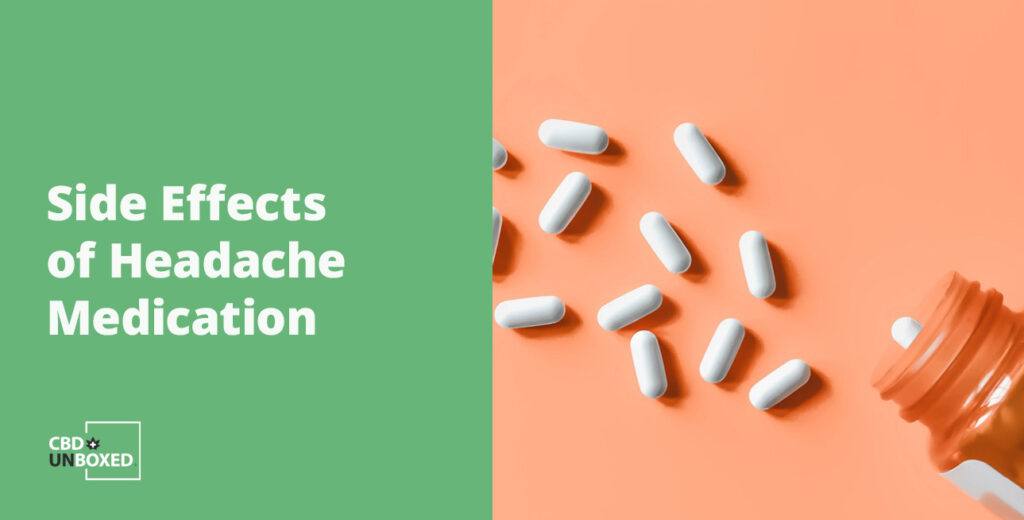
In total, it is estimated that the NHS spends around £250 million on care for all headache disorders (which includes migraines and any other types of headaches).
However, the cost to the wider economy is estimated to be around £6-7 billion each year, as headache disorders can be incredibly debilitating. That’s taking into account the costs of healthcare, lost productivity due to absenteeism and disability.
Whilst treating the root cause of pain is usually the best approach, however there’s currently no cure for headache sufferers as the cause of headaches is still baffling the medical community.
Acute headaches generally go away within a few hours or days once the cause of the pain has been identified and treated. Over the counter medicines such as paracetamol, aspirin or ibuprofen can help reduce the symptoms and work especially well if taken at the first signs of a headache as this gives them time to get absorbed into your bloodstream before the headache becomes too severe and debilitating.
Chronic headaches on the other hand are usually more complicated to deal with, especially if undiagnosed or if the root-cause is unknown. In cases where traditional over the counter medication does not work, your GP may prescribe something stronger or preventive medication, but these can be associated with side effects and cannot be taken for long periods of time.
Some of these include:
- Children under 16 should not take aspirin (unless prescribed by a GP)
- Aspirin and ibuprofen are not recommended for people who have stomach ulcers, liver or kidney problems.
- Medication can cause drowsiness, unbalanced gut micro-biome, gastrointestinal problems such as bleeding, ulceration and perforation
- Taking any form of painkiller frequently can make headaches worse. It has been reported that almost 75% of chronic migraine sufferers over use headache medications. This is known as painkiller headache or medication overuse headache (MOH).
On the other hand, physical and alternatives therapies such as acupuncture, massages or ice packs may only offer minimal relief and are not suitable for all types of headaches.
CBD Can Help Headache Sufferers
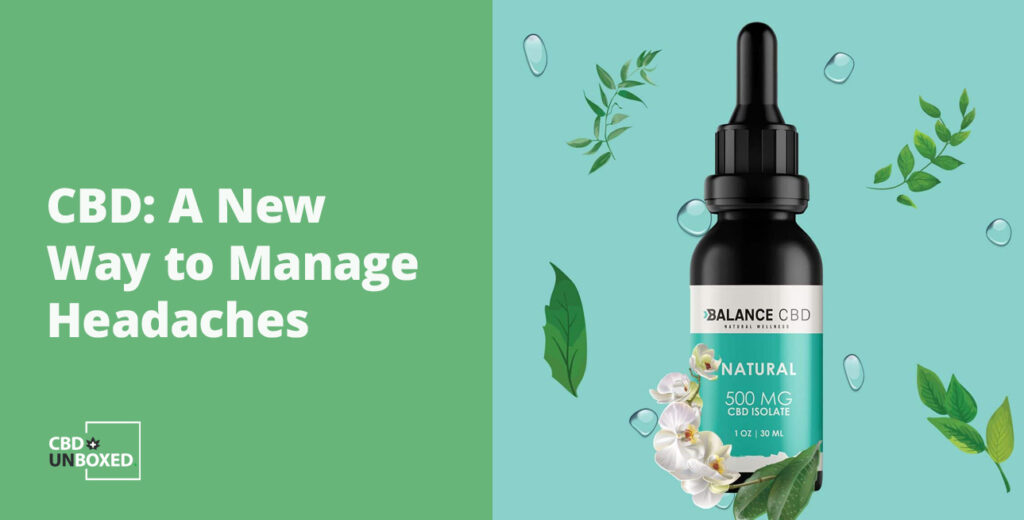
Although people have been using herbal remedies for sleep, anxiety, or pain for centuries, it wasn’t until the last few years that hemp’s legal status changed, allowing more people to benefit from its many health related benefits.
Cannabidiol, the scientific name for CBD, on the other hand is a naturally occurring compound coming from the hemp plant that helps people fight inflammation, pain and various health related issues.
Since no cure has yet to be found to treat headache disorders, it is important to not only manage the pain experience during a headache and its associated symptoms such as nausea and vomiting, but more importantly to focus on the factors that may influence attacks. These include lack of sleep and increased stress.
When it comes to migraines, the main properties of CBD include:
- Prevention: CBD can reduce the frequency of headaches
- Analgesic & anti-inflammatory: CBD relieves pain during and after a headache
- Headache triggers: CBD can helps with day-to-day events – such as stress and poor sleep – which may trigger headaches
- Antiemetic: CBD may prevent vomiting during a headache
CBD Can Reduce the Frequency of Headaches
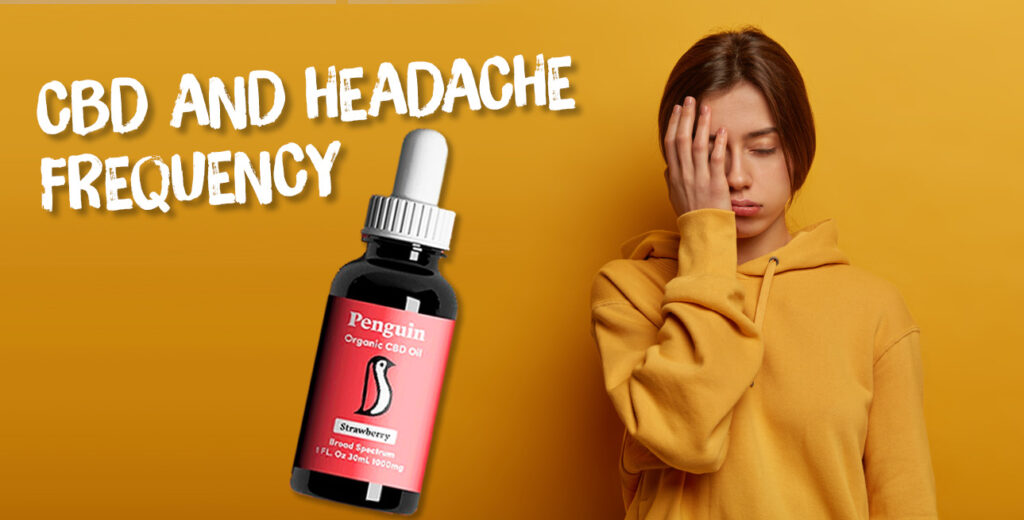
The results of a 2016 study indicate that medical cannabis may reduce the frequency of headaches and migraines. The study found that the frequency of headaches decreased from 10.4 to 4.6 headaches per month with the use of medical cannabis (of which CBD is a component). These positive effects were reported by 40% of patients with the most common effects reported being the prevention of headaches and the decreased frequency of headaches.
CBD Relieves Pain During a Headache

CBD has proven analgesic properties, meaning that it helps relieve pain during a headache. But how?
The human body contains a specialized system called the ECS (the endocannabinoid system), which aim is to regulate a variety of functions such as sleep, appetite, pain and immune system response. The body also produces endocannabinoids, which are simply neurotransmitters that bind to cannabinoid receptors in your nervous system.
CBD is believed to interact with specific receptors, specifically the CB1R and CB2R.
- CB1 receptors, which are located in various regions of the body, with a large concentration in the central nervous system and brain, co-ordinate mood, emotion, appetite, and other functions.
- CB2 receptors are more commonly found in the immune system and are responsible for controlling inflammation and pain. CBD stimulates these receptors and induces the body to release serotonin.
Serotonin, or 5-HT, is a neurotransmitter that carries signals from one neuron to the other. CBD increases the level of serotonin, which, in return, helps reduce pain, reduce inflammation in the body and possibly reduces the cramping experienced during period pain.
According to Researchgate, a study published in November 2019 shows improvement of physical discomforts such as headaches and various signs of physical pain. According to Teitelbaum J, there have been multiple studies showing patients found relief of menstrual pain, back pain, spinal pain, joint pain (e.g. arthritis) or fibromyalgia pain.
Furthermore, a 2018 review of the relevant research also reports that cannabis seems promising as a method of relieving pain, including pain from headaches and migraines.
CBD & Headache Triggers: Stress + Sleep
When it comes to headache disorders, some patients have ‘triggers’, which are things or events that make headaches more likely. Not all people with headache disorders have triggers, and triggers may affect some patients but not others. Two of the most common triggers are stress and not sleeping well.
The good news is that CBD can also help with these triggers.
CBD Can Reduces Stress
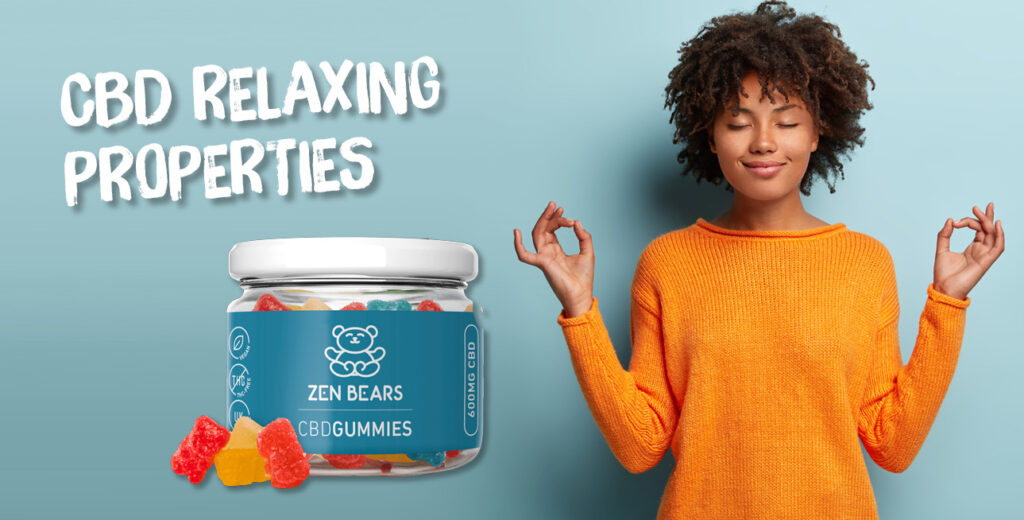
If your headaches are triggered by stress, we may have some good news for you. Whilst more research needs to be carried out to determine the impact of CBD on stress and anxiety disorders, a number of studies have already been carried out.
According to a double-bind 2010 study, subjects were either given 400mg of CBD or a placebo.
The results suggest that CBD reduces anxiety in SAD (social anxiety disorder) and that this is related to its effects on activity in limbic and paralimbic brain areas. Similar results were observed in another study conducted almost a year later.
A 2014 study shows that CBD acts similarly to ant-depressants and helps relieve stress in general.
Another study in 2018 saw CBD help with pain, anxiety, depression, and sleep disorders. According to the same study, the researchers claim to have just scratched the surface. The true potential of CBD oil is still unknown.
CBD Can Improve Sleep

Most people suffering from headache disorders may find that a lack of sleep or not being able to get restorative sleep are triggers. So how can CBD help?
There is extensive research on the effectiveness of CBD oil when used to treat insomnia and improve sleep.
CBD works with the human body to increase calm, decrease stress, and lower anxiety levels. These responses indirectly improve your sleep. In the 1990s, researchers confirmed the body has an endocannabinoid system or ECS. Researchers have only found a link between the cannabinoids found in hemp with the ECS, making it an unusual reaction.
The ECS is a complex cell-signalling system consisting of endocannabinoids, cannabinoid receptors, and enzymes. Scientists believe it plays many roles, including maintaining balance in the body. When it comes to sleep, the ECS helps regulate sleep and sleep cycles. Also, relating to sleep, a potential function is boosting anandamide to reduce depression and anxiety.
The cannabinoid receptors interact with endocannabinoids and cannabinoids. The CB1 is located in the nervous system and brain. Additionally, the CB2 is found mostly in the immune system and most organs.
A recent surge in scientific publications has found preclinical and clinical evidence documenting value for CBD in some neuropsychiatric disorders, including epilepsy, anxiety, and schizophrenia. Evidence points toward a calming effect for CBD in the central nervous system.
In 2019, a large case series was published in the Permanente Journal about CBD’s calming effects on the central nervous system. The studies showed patients taking CBD saw lower anxiety levels, experienced less stress, and slept better at night. Additionally, most participants experienced no or few side effects.
So through its calming effect, CBD may help people with headache disorders get a better night’s sleep.
CBD Prevents Nausea & Vomiting

If your headaches make you feel nauseous or if you often end up vomiting during an attack, CBD may be able to help as it has been proven to have antiemetic properties, meaning it helps prevent vomiting.
This discovery has been particularly useful for cancer patients for whom CBD has been proven to not only help them reduce the symptoms and side effects of cancer medication and treatments, such as pain, nausea and vomiting.
In one study focusing on CBD extract and THC extract given to patients with intractable cancer-related pain, it was found that of the 177 people with cancer-related pain who did not experience the adequate relief from traditional pain medication, those treated with an extract containing both the CBD and THC compounds experienced a significant reduction in pain compared to those who received only THC extract. This would therefore suggest that CBD had a net positive effect when it comes to reducing pain in cancer patients.
A separate study also showed that cancer patients who suffered from the various side effects of chemotherapy – including nausea and vomiting – experienced little relief from traditional anti-emetic treatments. Patients suffering from chemotherapy-induced nausea and vomiting (CINV) were administered a one-to-one combination of CBD and THC via mouth spray. The results showed that chemotherapy-related nausea and vomiting symptoms were reduced in comparison to standard treatment alone.
Both of these studies would support the fact that CBD has antiemetic properties which could apply to migraine sufferers.
CBD: The ‘Entourage Effect’

Now that you know that CBD can help you manage the frequency and severity of your headaches, it is important to understand the concept of ‘entourage effect’.
The entourage effect is the theory that while each botanical compound has a unique role or benefit, its behaviour may change when the presence of another compound is present.
For example, it would be more effective and quicker to produce a play with a team of actors rather than one actor playing all the parts. When each actor has a specific role to focus on, they can learn their lines and direction and support their fellow actors. But one actor alone will take a lot longer to learn all the lines for the various parts they have to play.
This is similar to the entourage effect. Essentially, everyone knows their role, but their performance can be enhanced by comradery.
But how is this applied to CBD?
CBD Entourage
We know that CBD products stimulate the endocannabinoid system and make it work more efficiently. But different CBD products affect the ECS differently, depending on their formulation. As previously, discussed there are 3 types of CBD formulation:
- Full-spectrum: No additional extraction, contains all the natural ingredients of the hemp plant, including CBD, THC, terpenes and flavonoids.
- Broad-spectrum: All traces of THC are removed from the oil. Every other ingredient remains.
- CBD Isolate: The oil only contains CBD, everything else is removed.
One of the above formulations has been proven to give better results in reducing pain, inflammation and many other symptoms. Which one of these formulations do you think stimulates the ECS best?
Would it be the most natural substance (full-spectrum), the one with any psychoactive ingredients (broad-spectrum) or the purest form of CBD (isolate)?
According to the entourage effect, it is the full-spectrum CBD because it keeps all the natural components of the hemp plant, which include:
Cannabinoids and Terpenes
The theory of the entourage effect was first introduced by Dr Ethan B. Russo. He thinks that cannabinoids such as CBD and THC work with terpenes (aromatic component) to produce a “synergy.”
In his study “Taming THC: Potential cannabis synergy and phytocannabinoid-terpenoid entourage effects” (2010) Dr Ethan B Russo suggests:
- The terpene pinene, which gives the scent of pine, may help counteract compromised memory caused by THC.
- CBD and terpene limonene, which gives a citrus scent, might work together to alleviate anxiety.
- A combination of CBD and terpene caryophyllene, offering a pepper smell, may be beneficial in the treatment of addiction.
The possibility of “synergy” of endless but have not yet been categorically proven. For more information read his other study “The Case for the Entourage Effect and Conventional Breeding of Clinical Cannabis: No “Strain, No Gain” published in 2019.
Omega-3, Antioxidants and Nutrients
In addition to CBD, THC and terpenes, full-spectrum CBD oil also contains Omega-3, which is vital to the ECS. Omega-3 is used to maintain the receptor CB1, which regulate pain and memory.
It also aids the absorption of external cannabinoids, as well as making endocannabinoids internally.
Other nutrients and antioxidants have also been discovered in full-spectrum CBD oil, for example, Vitamin E. Vitamin E is a fat-soluble compound that can prevent cataract formation, postpone the appearance of wrinkles and grey hair, boosts the immune system and reduces inflammation.
As you can see CBD oil when first extracted from the hemp plant has a huge list of ingredients. All of them seem to play a part in helping our bodies. We may not know exactly what they all do. But as time passes and research continues, we can learn more.
Is CBD Legal in the UK?

CBD oil, like any other natural remedy, has been used throughout the ages for its medicinal properties. It was evidenced to have been used in ancient societies with the first recorded case in 2727 B.C in China. It was used to treat anything from poor memory and malaria to gout. It has since been used throughout the world to treat various ailments from anxiety to insomnia and menstrual pains.
Throughout the 1940s, there was extensive research into isolating the CBD compound from the other 100+ compounds found within the marijuana plant, due to its lack of psychoactive effects.
It wasn’t until the 1970’s when the US legally recognised the medicinal worth of CBD oil, and it was decriminalised in Oregon. There was a large emphasis on the clear distinction between the CBD compound and the THC compound within the marijuana plant.
The UK followed suit in 2016, making it legal to buy CBD oil to help treat a multitude of health issues, including but not limited to:
- Depression and anxiety disorders (PTSD, OCD, panic disorder or substance/addiction disorders)
- Chronic pain and inflammation
- Epilepsy
- Heart issues
- Helps to reduce blood pressure and oxidative stress
- Diabetes
- Fight bacteria
- Insomnia and sleep related issues
- Helps with symptoms of schizophrenia,
- Skin conditions (psoriasis/eczema)
- Alzheimer’s disease
In a study conducted by the Centre for Medical Cannabis, their results showed that one in six adults in the UK had tried CBD oil, proving that it is one of the fastest-growing, contemporary, well-being products on the market.
Figures also show that the rates of people using CBD oil were higher amongst the under 55 age range. Also, figures were higher amongst females, with 62% of them using CBD to treat anxiety related issues.
How to Take CBD for Headaches?

There are a few ways to take CBD for headache disorders. Choosing a method is often a personal preference. The most common are tinctures, gummies, capsules, vapes and topicals.
CBD Tinctures

CBD oil is the most common way of getting your daily dose of CBD to help you reduce the frequency and intensity of your headaches.
However, whilst this is the most popular way to consume CBD, CBD oil often has a more earthy, nutty, woody or grass-like taste which is down to the fact the product is natural, safe, and non-toxic.
You can use CBD oil in different manners.
You can either place a few drops under the tongue and hold it there for 30 to 60 seconds. This way of consuming CBD – called sub-lingual. This is one of the best ways to get it absorbed into the bloodstream as this method allows CBD to completely bypass the digestive system and liver metabolism, so the compounds can avoid being broken down by enzymes and reach the bloodstream more quickly. This offers the quickest relief with an onset of 20 minutes or less.
For those who feel the earthy or grassy taste of CBD is too strong, another option is to mix it with a food or a drink to mask the taste. However, be aware that when you digest CBD, it will not provide immediate relief and you may need to wait 30 to 60 minutes for it to start working.
CBD Capsules

If the earthy and grassy taste of CBD oil or its sharp and bitter aftertaste is not for you, you may want to choose CBD capsules to experience all the benefits of CBD without any of the nasty taste or additives that gummies may contain (such as sugar).
CBD capsules are filled with a precise dose of CBD (usually between 10mg and 50mg of CBD per capsule). You can take one or two capsules, once or twice daily with a full glass of water. The CBD usually comes from full-spectrum (<0.01% THC) ground hemp and is rich in cannabinoids and terpenes. However, seeing as CBD capsules go through the digestive system, they take about an hour or so to work.
Choosing capsules is a great way to get your CBD intake and it’s incredibly travel friendly, the ideal solution for those who are always on the go.
CBD Gummies

For consumers who aren’t comfortable using the sublingual drops or those who struggle to swallow capsules, the CBD-infused chewy candies are a yummy way to consume the hemp extract.
Using CBD gummies is also an easy and accurate way of measuring that you are getting the right amount of CBD as each gummy will provide you with an exact dose of CBD (from 10mg to 50mg).
Unlike CBD oil which acts within 20-30 minutes as it gets absorbed into the blood stream, the onset for CBD gummies is about an hour as edibles need to go through the digestive system.
Finally, remember that gummies tend to contain additional ingredients – including sugar and additives. So whilst gummies are a convenient way to get your daily intake of CBD to treat your pain, eating 3-5 gummies each day could have a negative impact on your overall sugar intake! This isn’t always ideal and for that reason, we would always recommend going for CBD oil or CBD capsules whenever possible.
CBD Vapes

Whilst the team at CBD Unboxed isn’t pro-smoking or pro-vaping, using a vape and inhaling CBD is a great way to get your daily dose of CBD as the heating process occurring whilst smoking increases absorption.
How? By smoking CBD, the active compounds quickly enter the bloodstream via the lungs where they are transported throughout the body. Compared to oral intake such as gummies and capsules, vaping avoids the liver breaking down many of CBD’s beneficial compounds which reduces its potency.
Also, unlike edibles which often contain additional ingredients and additives, the only two ingredients present in CBD vapes and vape juices tend to be cannabinoids and terpenes, natural substances commonly found in herbs, fruits, flowers and plants.
Whilst this seems a great way to get your daily CBD intake, we cannot comment on its use or efficacy as we have not tried vaping products.
CBD Creams & Balms

Another great way to use CBD to reduce the intensity of a migraine attack is by using topical CBD in the form of creams, balms or salves.
Hemp extract creams are applied directly to the relevant area, be it the temples, the forehead or the back of the head and neck. These applications are often combined with other ingredients that help reduce pain, such as turmeric, ginger, and capsaicin.
As CBD creams are for topical use, it can take a while to penetrate and may not provide fast-acting relief. For that reason, it is usually best to combine a topical with a fast acting product such as a CBD oil which will get to work in less than 30 minutes.
For the Ultimate Relief: Mix & Match
An excellent option is to combine the methods. Your CBD tincture, when taken under the tongue, can take up to 30 minutes to fully work. To ease discomfort while waiting, many consumers may use a CBD vape pen which may act faster.
The same advice works for other methods. Your topical CBD cream will take at least 30 minutes to provide relief, and gummies and capsules go through the digestion process and have an average onset time of 30 to 90 minutes. By using multiple methods, you may be able to reduce discomfort and pain during a migraine attack.
How Much CBD Should I Consume?

CBD doesn’t have one-size-fits-all dosing and calculating a proper dosage of CBD can be tough as our bodies react to it differently.
The four major factors affecting your CBD dosage are:
- Your weight
- The condition being treated (i.e. depression, chronic pain etc)
- The severity of your condition
- The concentration of CBD oil
Most brands recommend customers start with the lowest dose and increase until they find the right serving size that fits their needs. The most common starting amount is between 10mg and 25mg. For anxiety and depression, the dose can vary from 20mg to 50mg or more.
As a rule of thumb, a person weighting between 10.5 and 17 stones (approximately 150 and 240 lbs) may need between 18mg and 27mg of CBD per day depending on the severity of their symptoms.
When using CBD for the first time, we would always recommend starting with a one of two drops of the 3% or 6% CBD oil placed under the tongue (sublingual) and holding it there for at least 30 seconds so it can absorb into the bloodstream.
Taking it first thing in the morning on an empty stomach to see how your body reacts to it is also recommended. If you are not seeing any major benefits with a single drop, increase your intake by a single drop every 2 or 3 days until finding the right balance to treat your personal symptoms.
How Many Drops Should You Take?
Whilst it may be confusing at the beginning, it’s incredibly simple to work out how many drops of CBD oil you need to take depending on your daily requirements and the strength of the product you bought.
Most bottles of CBD oil contain 10ml of product and come in strengths ranging from 300mg to 2,400mg – also known as 3% and 24% CBD oils. This simply means that in a 1ml drop of the 300mg bottle, you will have 30mg of CBD, whilst the same 1ml of the 2,400mg bottle will give you 8 times that amount for a total of 240mg of CBD.
So assuming you need to hit 25mg of CBD per day with, you will need:
| CBD / Bottle* | CBD / Drop | # Drops |
| 500mg | 1.25mg | 20 drops |
| 1000mg | 2.5mg | 10 drops |
| 1800mg | 4.5mg | 5.5 drops |
| 2400mg | 6.0mg | 4 drops |
*Based on 10ml bottles
Assuming you are using the 500mg CBD oil for a daily dose of 25mg, you will need to take approximately 20 drops per day (25mg divided by 1.25mg per drop). You could break this down throughout the day by taking:
- 8 drops first thing in the morning on an empty stomach
- 6 drops early afternoon
- 6 drops at night before going to bed
If however you bought the 2400mg CBD oil for a daily dose of 25mg, you would only need to take 4 drops per day (25mg divided by 6mg per drop), which you could also spread across the day – 2 in the morning, one in the afternoon and one in the evening.
As with everything, start with a small amount of CBD oil daily to make sure there’s no reaction, then increase slowly by a drop every 1-2 days until finding the right balance.
If you feel that the frequency and intensity of your migraines has decreased by increasing your daily CBD intake and you don’t experience any particular side effects, you have found your sweet spot. If however you still experience frequent attacks and major discomfort during each attack, try increasing your CBD intake slowly, but remember that the Food Standards Agency (FSA) recommends that healthy adults do not take more than 70mg a day, unless advised by a medical professional.
What to Expect when Taking CBD?

First-time users may experience relief immediately, as CBD is brand new to your ECS. However, this does depend on the ailment you are trying to improve. For example, one dose of CBD could relieve pain, reduce anxiety and reduce nausea but it wouldn’t stop seizures, cure your depression or diabetes.
If it took you a long time to get the symptom then the same will be said for reducing, preventing or eliminating it.
Immediate Relief (After 24 hours a noticeable difference is seen):
Pain, Inflammation, Migraines, Nausea, Anxiety, Arthritis, Epilepsy, Glaucoma, Stress, Insomnia, Multiple Sclerosis, PTSD, Rheumatism and Motion Sickness.
Short Term Relief (Noticeable between 2-14 days):
Acne, Inflammation, ADD/ADHD, Anxiety, Arthritis, Epilepsy, Depression, Stress, Insomnia, Multiple Sclerosis, PTSD, Rheumatism, Endocrine Disorders, Obesity, OCD, Spinal Cord Injury and Rheumatism.
Long Term Relief (Noticeable between 2+ weeks):
ALS, Addiction, Alzheimer’s Disease, Asthma, Atherosclerosis, Autism, Bipolar Disorder, Cancer, Inflammatory Bowel Disease, Depression, Diabetes, Endocrine Disorders, Fatty Liver Disease, Fibromyalgia, Heart Disease, Huntington´s Disease, Kidney Disease, Metabolic Syndrome, Mood Disorders, Neurodegeneration, Obesity, Parkinson´s Disease, Prion Disease, Schizophrenia and Traumatic Brain Injury.
As you can see from the table above, symptoms which occur quickly can be improved in the same short time frame. Progressive illnesses and their more severe side effects require longer exposure to CBD before a real difference can be seen.
This is just a general guide, and it’s important to note that every single person will react differently to CBD as no one person has the same biology and lifestyle.
What are the Side Effects of CBD?
Most people do not experience any side effects when taking CBD as this is a natural product. However, as with everything, some people may experience mild side effects from the hemp extract, including:
- Diarrhoea
- Changes in appetite and weight
- Nausea
- Fatigue
- Irritability
- Drowsiness
The best way to decrease adverse reactions is to simply lower your daily intake of CBD, or if taking CBD oil under the tongue, to mix it with your food and drink to mask the taste and reduce potential side effects as the CBD will be processed by the digestive system – which means slower absorption. But be aware that one of the downsides of mixing it with your food is a decreased bioavailability, so CBD may not work as well for you.
How To Choose Quality CBD?

As with anything you ingest, the source and quality of your CBD products are important. We would always recommend looking at five main aspects before choosing your CBD product.
CBD Oil from Organic Hemp
Hemp can be grown in just the same way as any other plant – mass-produced and using pesticides and GMOs for the greatest profit, or grown organically with care and attention to provide a fantastic end product.
The best CBD is produced from organic hemp that has benefited from plenty of rain during the growing process. While hemp can physically be grown in many countries, it grows best when the temperature is in the low twenties Celsius. Therefore, the location of the hemp farm is important to ensure the optimum environmental factors are accommodated.
And seeing as cannabis plants can be stressed out by the weather, resulting in a higher THC content (above 0.2%), it’s important to ensure that your CBD oil comes from organic hemp which has been grown in the right part of the world.
Less Than 0.2% THC
Cannabis flowers and extracts usually contain two cannabinoids known as THC (tetrahydrocannabinol) and CBD (cannabidiol). Yet the exact percentage of each can vary greatly, depending on the plant variety and the growing technique used.
THC is the main psychoactive compound in cannabis that produces the high sensation, while CBD has been associated with health benefits.
The EU common agricultural policy states that cannabis plant can be grown for industrial uses, provided their THC content does not exceed 0.2 %. That’s in the plant, not in the CBD product you buy.
So when buying CBD oil from a shop or online retailer, be sure to check that their products contain less than 0.2% THC.
Clean Extraction Method
Once the hemp is grown and harvested, the CBD needs to be extracted from the plant. There are several methods for doing this, including the use of carbon dioxide (CO2). This produces the cleanest and purest CBD extract but can be expensive to do as the machinery required is not cheap.
Alternative methods include using solvents such as ethanol or plant oils (eg olive oil) to extract the CBD.
This can lead to less-pure CBD extract, as small amounts of solvent or oil can remain, although most companies using this type of extraction method will usually test their CBD extracts to ensure they are solvent free and safe to consume.
Tested by Independent Labs
Another thing we would recommend checking is whether or not your CBD oil has contaminants. That’s because cannabis plants readily absorb heavy metals, pesticides, and other potentially harmful chemicals that may be in the soil or water.
To ensure your CBD oil is free of those harmful chemicals, it should be tested frequently while the hemp is growing, and finished products should also be tested, using validated methods.
The extract should be tested and certified by a third-party laboratory to confirm the quality of the CBD. Organic CBD should be GMO-free, pesticide-free, and as pure as possible. In the UK and EU, CBD must register THC content of 0.2% or lower.
Most reputable companies selling CBD oil in the UK publish their lab results on their website. Below are a few examples of companies that play the transparency card with their customer and share their lab results for each batch of CBD they produce:
- Blessed CBD
- Provacan
- Hempura
- Endoca
- Naturecan CBD
- Medterra
- Love CBD
Strength to Match your Needs
Finally, the CBD level within any product should be of a suitable strength to match your needs. Every person is different and their body will respond in a slightly different way, so the level may partially be down to personal preference.
However, higher concentrations might be more suitable for treating different ailments to lower concentrations, and it is wise to check the level of CBD in every product you use.
As a rule of thumb, people looking to use CBD for sleep, anxiety, digestion, relaxation or stress might take between 10mg and 25mg of CBD daily and use the lowest strength (300mg to 600mg), whilst those using CBD as a pain relief for conditions such as severe arthritis, back pain or migraines may want to take 30mg to 50mg of CBD per day and use higher concentration products (1200mg to 2400mg).
So remember that CBD oil comes in different concentration and that this will impact how many drops you need to take – for example Blessed 500mg CBD oil (5%) contains 1.25mg of CBD per drop, whilst their 1800mg CBD oil (18%) contains 4.5mg of CBD per drop.
Top 5 CBD Oils for Headaches

With over 150 CBD brands on the market, it can be difficult to choose the right CBD product. This is why the CBD Unboxed team has tried and tested all most CBD products and brands available in the UK market and assessed them across 6 key areas:
- Efficacy
- Taste
- Value for Money
- Third Party Certification
- Packaging
- Shipping & Delivery
Based on our findings and whilst every person will be different, we would recommend the below five CBD oils to start with.
- 10ml bottle (1000mg of CBD)
- 10% concentration
- Approx 2.5mg of CBD per drop
- Broad spectrum CBD
- Zero THC
- Organic MCT carrier oil
- Entourage effect
- 30ml per bottle (3000mg of CBD)
- 10% concentration
- Approx 2.5mg of CBD per drop
- 99%+ Pure CBD (isolate)
- Zero THC
- MCT oil carrier
- 10ml per bottle (1000mg of CBD)
- 10% concentration
- Approx 4mg of CBD per drop
- Full spectrum CBD
- Less than 0.2% THC
- Hemp seed oil carrier
- Entourage effect
- 10ml bottle (1200mg of CBD)
- 12% concentration
- Approx 3mg of CBD per drop
- Full spectrum CBD
- Less than 0.05% THC guaranteed
- Olive oil carrier
- Entourage effect
- 10ml bottle (2000mg of CBD)
- 20% concentration
- Approx 8mg of CBD per drop
- Broad spectrum CBD (THC free)
- Organic MCT carrier oil
- Entourage effect
- Suitable for vegans
- 10ml bottle (1500mg of CBD)
- 15% concentration
- Approx 5mg of CBD per drop
- Full spectrum CBD
- Less than 0.2% THC
- Hemp seed oil carrier
- Entourage effect
- 20ml per bottle (2000mg of CBD)
- 10% concentration
- Approx 16mg of CBD per spray
- Broad spectrum CBD
- Zero THC
- Olive oil carrier
- Entourage effect
- 30ml per bottle (2000mg of CBD)
- Approx. 8.3mg of CBD per spray
- Approx. 240 sprays per bottle
- Broad-spectrum CBD
- Zero THC
- MCT oil carrier
- 10ml per bottle (1000mg of CBD)
- 10% concentration
- Approx 5mg of CBD per drop
- Full spectrum CBD
- Less than 0.02% THC
- Hemp oil carrier
- Entourage effect
Bud & Tender CBD
Bud & Tender CBD Oil 1000mg (10%)
£80.00
Medterra CBD
Medterra CBD Oil 3000mg (10%)
£89.99
Blessed CBD
Blessed CBD Oil 1000mg (10%)
£74.95
Provacan CBD
Provacan CBD Oil 1200mg (12%)
£69.99
Naturecan CBD
Naturecan CBD Oil 2000mg (20%)
£84.99
Endoca CBD
Endoca CBD Oil 1500mg (15%)
£119.00
Love CBD
Love CBD Entourage Oil 2000mg (10%)
£99.99
Four Five CBD
Four Five CBD Oil 2000mg (6%)
£90.00
Hempura CBD
Hempura CBD Oil 1000mg (10%)
£64.99
Take the CBD Quiz
Still unsure what product is best for you? Take our CBD Quiz to find out which CBD product, brand and strength is best suited to your personal needs.









